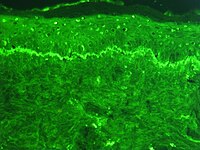Immunofluorescence: Difference between revisions
| Line 53: | Line 53: | ||
{{refbegin}} |
{{refbegin}} |
||
* [http://cta-lab.com/direct_immunofluorescence.html Direct Immunofluorescence Lab Services] at CTA Lab |
|||
* [http://www.ii.bham.ac.uk/clinicalimmunology/CISimagelibrary/ Images associated with autoimmune diseases] at [[University of Birmingham]] |
* [http://www.ii.bham.ac.uk/clinicalimmunology/CISimagelibrary/ Images associated with autoimmune diseases] at [[University of Birmingham]] |
||
* [http://www.confocal-microscopy.org/Protocols%20-%20Immunofluorescence.htm Immunofluorescence protocol and confocal microscopy resources] at confocal-microscopy.org |
* [http://www.confocal-microscopy.org/Protocols%20-%20Immunofluorescence.htm Immunofluorescence protocol and confocal microscopy resources] at confocal-microscopy.org |
||
Revision as of 16:17, 25 August 2009


Immunofluorescence is the labeling of antibodies or antigens with fluorescent dyes. This technique is often used to visualize the subcellular distribution of biomolecules of interest. Immunofluorescent-labeled tissue sections or cultures are studied using a fluorescence microscope or by confocal microscopy.
Uses
Most commonly, immunofluorescence employs two sets of antibodies: a primary antibody is used against the antigen of interest; a subsequent, secondary ("indirect"), dye-coupled antibody is introduced that recognizes the primary antibody. In this fashion the researcher may create several primary antibodies that recognize various antigens, but, because they all share a common constant region, may be recognized by a single dye-coupled antibody. Typically this is done by using antibodies made in different species. For example, a researcher might create antibodies in a goat that recognize several antigens, and then employ dye-coupled rabbit antibodies that recognize the goat antibody constant region (denoted rabbit anti-goat). This allows re-use of the difficult-to-make dye-coupled antibodies in multiple experiments.
In some cases, it is advantageous to use primary antibodies directly labelled with a fluorophore. This direct labelling decreases the number of steps in the staining procedure and, more importantly, often avoids cross-reactivity and high background problems. Fluorescent labelling can be performed in less than one hour with readily available labeling kits.
As with most fluorescence techniques, a significant problem with immunofluorescence is photobleaching. Loss of activity caused by photobleaching can be controlled by reducing the intensity or time-span of light exposure, by increasing the concentration of fluorophores, or by employing more robust fluorophores that are less prone to bleaching (e.g. Alexa Fluors or DyLight Fluors).
Many uses of immunofluorescence have been outmoded by the development of recombinant proteins containing fluorescent protein domains, e.g. green fluorescent protein (GFP). Use of such "tagged" proteins allows much better localization and less disruption of protein function.
Protocol
This section contains instructions, advice, or how-to content. (July 2009) |
Coverslip preparation
- Coat sterile coverslip with either Gelatine (0,1% in dH2O) or polyaminoacid poly-ornithine (0,1mg/ml; e.g. for Cerebella primary cell culture)poly-D-Lysine (0,1mg/ml, e.g. Cortex). Coat with polyaminoacid either in bulk or in plate
- Wash coverslips with dH2O or PBS if coating with polyaminoacid and let dry!
- If necessary coat coverslips with Fibronectin (e.g. bovine plasma, Calbiochem) 50µg/ml in DMEM w/o serum, diluted from 1mg/ml stock 45min at RT, gently rocking; wash 1x with DMEM
- Seed cells in appropriate density the day before transfection (e.g. 1,5x105c/6well for HeLa; 1-1,5x105c/6well for NIH-3T3)
Transfection
- If needed, transfect cells using Exgen (1- max 3µg pDNA / 6well well; 8 equivalents = 13µl/well for 3µg DNA in 100µl 150mM NaCL/1ml +DMEM or 200µl NaCL/2ml +DMEM; spin 280rcf, 5min at RT; change media after 4h til ON incubation)
- Wash cells 2x in either PBS or TBS
Fixation
- Fixation of cells using 4% PFA (Formaldehyde) in PBS/TBS or CBS (Cytoskeleton Buffer with Sucrose; if staining cytoskeletal filaments) for 5-20min at RT; or using 100% -20°C Methanol 5-20min at RT (Methanol will lead to denaturing of the protein)
- Wash cells 2x with PBS/TBS
Staining
- For Immunostaining permeabilize the cells with 0.2-0.5% Triton-X 100) in TBS 20min @ RT (harsh) or 0.05-0.1% Saponin in PBS/TBS 20min at RT (mild)
- Rinse with TBS-0,1%TX
- Block cells with either in Abdil (Antibody Dilution Solution 2% BSA) 10min @ RT or 5-10% Goat serum (in TBS) 60min at RT; or Serum appropriate for secondary antibody (ideally serum of 2nd AB producing host).
- Incubate with 1st AB overnight at 4°C in Abdil (or PBS/0.1% Triton-X 100) (e.g. 1:50-1:1000). If labelling with more than one AB apply all together (if that does not work, one after another). Pipette 50-100µl directly onto cover slip and place piece of Parafilm on top; seal plate with Parafilm
- Wash 3x 10min with TBS-0.1%TX
- Incubate with 2nd AB in Abdil (or PBS/0,1% Triton-X 100 1h at RT) (e.g. αRabbit-Cy3 1:200; Alexa-Flour-Dyes work well 1:500)
- Wash 3x 10min with PBS-0.1%TX (if counterstaining with Phalloidin or DAPI, proceed with staining after 2nd wash step)
References
External links
- Direct Immunofluorescence Lab Services at CTA Lab
- Images associated with autoimmune diseases at University of Birmingham
- Immunofluorescence protocol and confocal microscopy resources at confocal-microscopy.org
- Immunofluorescence Staining Protocol
- Overview at Davidson College
- Immunofluorescence at the U.S. National Library of Medicine Medical Subject Headings (MeSH)
